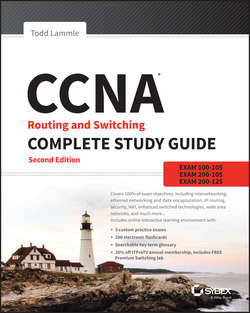Читать книгу CCNA Routing and Switching Complete Study Guide - Todd Lammle - Страница 12
На сайте Литреса книга снята с продажи.
Part 1
ICND1
Chapter 1
Internetworking
Exam Essentials
ОглавлениеIdentify the possible causes of LAN traffic congestion. Too many hosts in a broadcast domain, broadcast storms, multicasting, and low bandwidth are all possible causes of LAN traffic congestion.
Describe the difference between a collision domain and a broadcast domain. Collision domain is an Ethernet term used to describe a network collection of devices in which one particular device sends a packet on a network segment, forcing every other device on that same segment to pay attention to it. With a broadcast domain, a set of all devices on a network hears all broadcasts sent on all segments.
Differentiate a MAC address and an IP address and describe how and when each address type is used in a network. A MAC address is a hexadecimal number identifying the physical connection of a host. MAC addresses are said to operate on layer 2 of the OSI model. IP addresses, which can be expressed in binary or decimal format, are logical identifiers that are said to be on layer 3 of the OSI model. Hosts on the same physical segment locate one another with MAC addresses, while IP addresses are used when they reside on different LAN segments or subnets.
Understand the difference between a hub, a bridge, a switch, and a router. A hub creates one collision domain and one broadcast domain. A bridge breaks up collision domains but creates one large broadcast domain. They use hardware addresses to filter the network. Switches are really just multiple-port bridges with more intelligence; they break up collision domains but create one large broadcast domain by default. Bridges and switches use hardware addresses to filter the network. Routers break up broadcast domains (and collision domains) and use logical addressing to filter the network.
Identify the functions and advantages of routers. Routers perform packet switching, filtering, and path selection, and they facilitate internetwork communication. One advantage of routers is that they reduce broadcast traffic.
Differentiate connection-oriented and connectionless network services and describe how each is handled during network communications. Connection-oriented services use acknowledgments and flow control to create a reliable session. More overhead is used than in a connectionless network service. Connectionless services are used to send data with no acknowledgments or flow control. This is considered unreliable.
Define the OSI layers, understand the function of each, and describe how devices and networking protocols can be mapped to each layer. You must remember the seven layers of the OSI model and what function each layer provides. The Application, Presentation, and Session layers are upper layers and are responsible for communicating from a user interface to an application. The Transport layer provides segmentation, sequencing, and virtual circuits. The Network layer provides logical network addressing and routing through an internetwork. The Data Link layer provides framing and placing of data on the network medium. The Physical layer is responsible for taking 1s and 0s and encoding them into a digital signal for transmission on the network segment.
